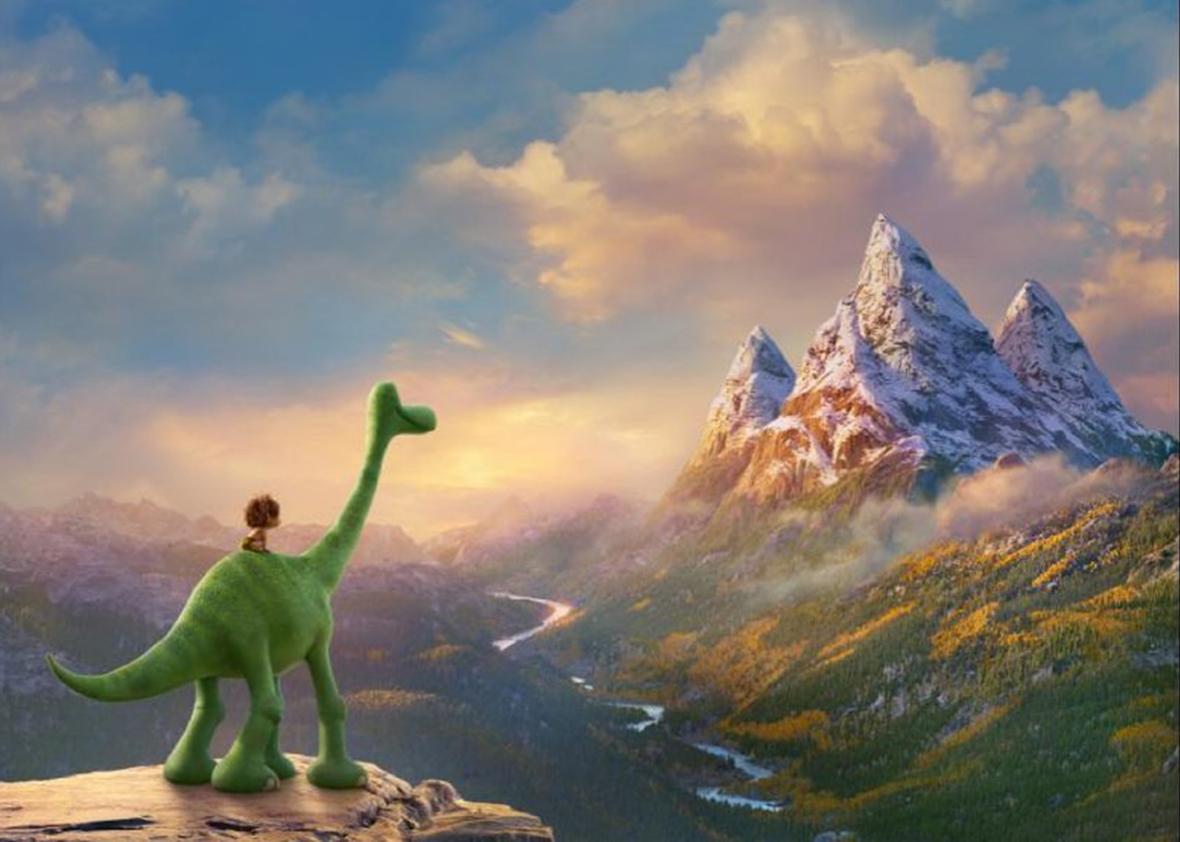Pixar has created convincing settings before: the teensy Paris apartment where Remy and Linguini learn to make culinary magic; the sleek and steely Buy n Large starliner the Axiom; the ever-changing emotional control room inside Riley’s brain. The company’s production designers and animators have always been attuned to the importance of creating real, tangible places for its celebrated characters to grow, cry, crack wise, and have adventures.
But they’ve never created a convincing, cohesive world—until now. The Good Dinosaur, Pixar’s uneven but astoundingly beautiful new film, is many things: an adventure story pitched at an 8-year-old’s emotional tenor; a counterhistory of dinosaur civilization; a Lassie-style boy-and-his-dog tale. But above all, it’s a reminder that, in the realm of landscape, contemporary computer animators are no longer constrained in any way from capturing the natural world in all its glory.
In The Good Dinosaur, rivers rage and streams trickle precisely as real rivers and streams do. The clouds scudding across the sky are real clouds. Evergreen-studded mountain faces span the screen, each tree precise and true; here and there, bare patches show the damage of wind or storms or fire or just the bare rock where life hasn’t yet found a foothold. Travertine hot-spring terraces steam in the morning light. Sunsets are glorious. The moon rises on the horizon, creamy as life. As far as my dazzled eyes could tell, Pixar somehow found a way to transport Roger Deakins and an Imax camera back to a prehistoric, ahistoric earth, and gave him an unlimited budget for lenses.
Is that a good enough reason to see The Good Dinosaur? Yes. Luckily, the movie’s also a fun adventure, though one less in the mature emotional register of, say, Inside Out, and more in Pixar’s simple, tot-pleasing Cars mode. (It’s way more ruminative and less antic than Cars, though.) Set tens of millions of years ago on an Earth where the asteroid that would have caused the Cretaceous-Paleogene extinction event narrowly missed, it features dinosaurs who talk, plan, and farm, interacting with recently evolved humans.
Arlo (voice of Raymond Ochoa), a young Apatosaurus, has trouble fitting in on his family farm. Given the job of ridding the farm of a “critter” who’s stealing their corn, Arlo leaps at the chance to be of use but disappoints his father (Jeffrey Wright) when he can’t finish the animal—in fact, a human child—off. Soon Arlo is lost in the wilderness, trying to find his way home, accompanied by that growling, doglike child (Jack Bright), whom Arlo befriends and names Spot.
At times the storyline of The Good Dinosaur reflects the accumulated clutter of a reportedly complicated production process. (The original director, Bob Peterson, was replaced in August 2013, and with the installation of new director Peter Sohn, Pixar revised the story substantially. The film’s screenplay is credited to Meg LeFauve, though she’s among five writers receiving story credits, and even more writers appear in the credits as supplying “additional screenplay material.”) As Arlo and Spot make their way through the wilderness, they encounter wacked-out Pterodactyls, longhorn-herding T. Rexes, and rustling raptors. These scenes, usually played for comedy, pair uneasily with the quieter, stronger moments of bonding between the (dinosaur) boy and his (human) dog. Spot, like Arlo, is alone in the world, and the relationship between them is elementally satisfying to watch develop.
The slight incompatibility of the film’s story elements is mirrored in its fascinating character design. The Good Dinosaur’s Paleolithic flora and fauna—huge beetles, shy foxes, vividly plumaged birds—are animated with careful realism. But the film’s sentient creatures—dinosaur and human—are cartoony: Spot’s a bright and vivid combination of boy and Taz, while Arlo’s family is pleasingly geometric, their long cylindrical legs like extruded Play-Doh columns. Watching these figures move through the film’s near-photorealistic landscapes can be disconcerting at first, but I grew to love the way the characters were often made small and toylike against breathtaking grandeur. And the animation teams make their dinos expressive, giving Arlo big curious eyes and a gait that’s fluid and smooth on familiar terrain but ill-suited to the mountains he must clamber across to get home.
The Good Dinosaur sometimes feels a bit too simple, its philosophy of “making your mark” within a family an exceptionally mild goal, even by the standards of animated family films. A long interlude in which Arlo rides the plains with a team of rowdy T. Rex cowpokes is pure kidnip to which nearly every adult will be impervious. (Adults will, however, enjoy the scene in which ’shroom-eating Arlo and Spot become the first Disney heroes since Dumbo and Timothy Q. Mouse to get totally wasted.) But the silliness is more than made up for with moments of stillness and quiet connection between characters learning to need each other in lovely ways.
And most of all, there’s the glorious landscape, Yellowstone as it might have been millions of years ago, wilder and even more beautiful than it is today. See it in 3-D if you can, hold your kid’s hand, and take a trip to a place you’ll never see anywhere else, created by volumetric cloud supervisors and atmos technicians and water team leads. I didn’t love everything about The Good Dinosaur, but I loved visiting the world Pixar made.
